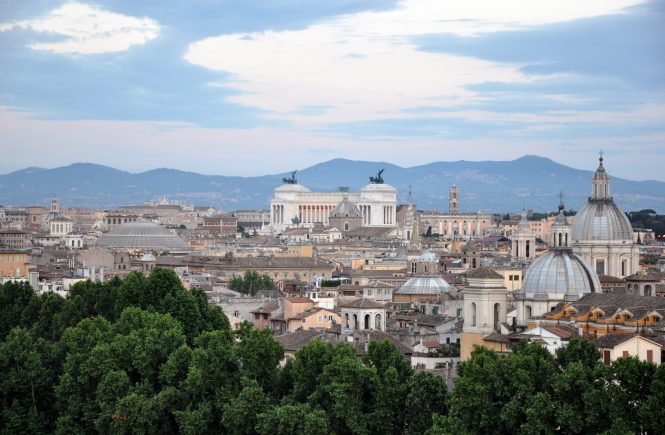Don't want to plunk down cash or credit for Rome's (pricy) accommodation? No problem: From Nov. 18 to 24, 83 B&Bs in Rome will—get this—accept a bartered good or service instead. And 35 are actually open to the idea year-round. Find out more with my piece over at BBC Travel.
Five Most Overrated Things to Do in Rome… And What to Do Instead
 Want to know the best things to do in Rome—beyond seeing the Sistine Chapel and the Colosseum? Then put away your guidebook. When they go beyond the main sites, too many books (and magazine articles, and television shows) provide the same tired, touristy list of things to do and places to go in Rome.
Want to know the best things to do in Rome—beyond seeing the Sistine Chapel and the Colosseum? Then put away your guidebook. When they go beyond the main sites, too many books (and magazine articles, and television shows) provide the same tired, touristy list of things to do and places to go in Rome.
The problem: These places aren’t only overrun with tourist crowds, but often just don’t tick the box they’re supposed to.
Here are five of Rome’s most overhyped activities—and what to do instead.
1. Instead of having a coffee at Piazza del Popolo…
 Don’t get me wrong: The large, obelisk-topped Piazza del Popolo is worth a stop. (Don’t miss the Church of Santa Maria del Popolo, with its Caravaggio paintings). But it’s not where to go for a cup of coffee. The couple of cafes on the piazza are scams expensive (think €4.50 for an espresso) and the service is terrible—which is why you won’t see any locals there.
Don’t get me wrong: The large, obelisk-topped Piazza del Popolo is worth a stop. (Don’t miss the Church of Santa Maria del Popolo, with its Caravaggio paintings). But it’s not where to go for a cup of coffee. The couple of cafes on the piazza are scams expensive (think €4.50 for an espresso) and the service is terrible—which is why you won’t see any locals there.
My Favorite Agriturismo in Italy: An Ode, in Photos
When I need a break from Rome’s hustle and bustle, I head to the countryside. And when I’m there, I always stay at an agriturismo, or “farm-stay”—or Italy’s best-kept accommodation secret.
Over the course of my travels in Italy, I’ve probably stayed in more than 50 different agriturismi. Not once have I been disappointed. Each one has had its own character, but they’ve all been comfortable, in beautiful settings, and a better value than any hotel. And no, you don’t have to milk a cow or collect eggs to stay at one.
When I’m asked about my favorite agriturismo in Italy, though, there’s always one that comes to mind: Fontanaro.
Fontanaro and its sister property, Tartagli, are located on the border of Umbria and Tuscany, a 2-hour drive from Rome (or a 1.5-hour drive from Florence). They’re a stone’s throw away from the tiny, medieval village of Paciano.
Made up of rolling hills and vineyards, the Fontanaro properties produce a huge variety of Tuscan-Umbrian staples, from olive oil to honey. Better yet, everything is grown organically. And the estate, run by mother-daughter team Lucia and Alina Pinelli, uses sustainable energy whenever possible; the farm was one of the first in Umbria, in fact, to use solar panels.
National Geographic Traveler Article on Rome B&Bs, Now On Newsstands
I’m excited to say that my article on Rome’s best pensiones for National Geographic Traveler is now on newsstands! Grab a copy of the November 2012 issue to see my top picks. (Update, Nov. 9: You can now read the article online here).
Rome Neighborhoods: How to Know Where to Stay (Updated for 2018)
Figuring out the neighborhoods of Rome can be a little confusing. Even though it’s a big city, most tourists spend most of their time in the centro storico — and that’s where most hotels are, too.
But simply looking for accommodation in Rome’s “historic center” isn’t enough. That’s because the center is divided by neighborhoods, some of which feel pretty different from the next.
So you’ll need to know not only that you want to stay in the historic center… but which neighborhood to stay in in the centro storico, too.
What is the centro storico?
If you want to stay in the centro storico, you first need to know… what is the centro storico.
Technically, the centro storico is the area of Rome that’s bordered by the 3rd-century Aurelian walls and by the mura gianicolensi, which include the Vatican walls. There aren’t many good maps online that have the walls clearly delineated. This is one of the best I could find.
The thin, black line running around the entire center is the Aurelian walls. (You can find it by looking at the square marked “Castro Pretorio” in the upper right-hand part of the city). Although the neighborhood and monuments are all ancient Roman, you can get some perspective by looking for the Colosseum (a little ring almost right in the center), Circus Maximus (to the southwest of the Colosseum), and the Tiber.
This area—which includes not only the Colosseum and forum, but the Spanish Steps, Piazza del Popolo, Piazza Navona, Pantheon, and Vatican — is the historic center. And if you’re staying in Rome, this is where you’ll probably want to stay. (Nota bene: There are, of course, many other, perfectly pleasant neighborhoods in Rome outside of the historic center. But I’m sticking to the centro storico here just because it tends to be most conveneint for most people).
Now, for the neighborhoods. (I recommend opening a tab with Google maps and keeping it handy so you can refer back and forth!).
The neighborhood where… everyone stays: the heart of the centro storico
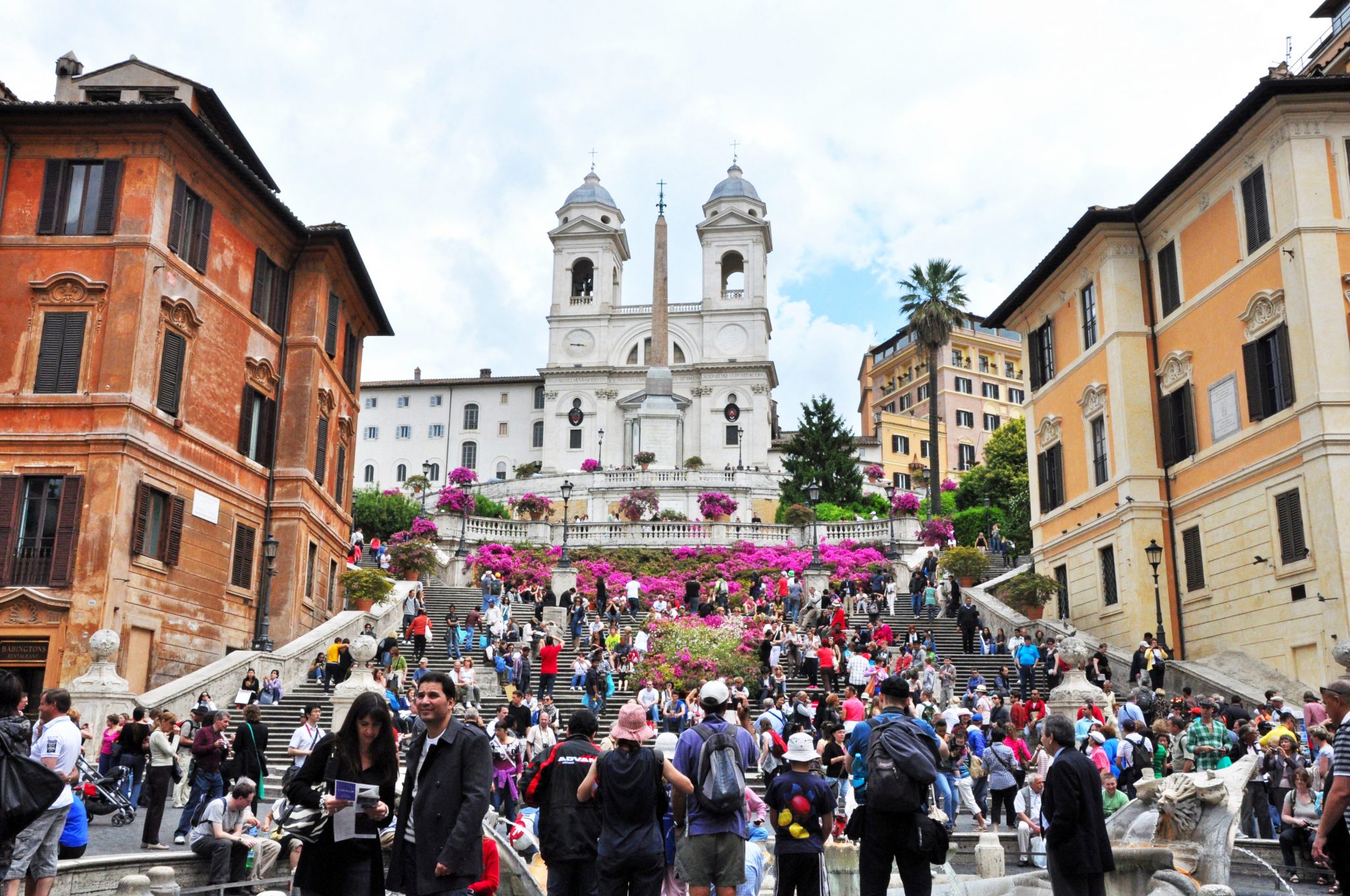
This isn’t technically a neighborhood, but I’m using it as shorthand for the central area that most people think of when they think “Rome”—the triangle with Piazza del Popolo in the north, the Spanish Steps and Trevi Fountain to the east, and the Pantheon and Piazza Navona to the west.
This stunning area is home to cobb where most people want to stay. Of course, it’s also where hotels are the most expensive, where the streets crowd with tourists and shoppers, and where 99% of restaurants are overpriced and mediocre. On the other hand, every corner looks like a postcard. Hey, you win some, you lose some!
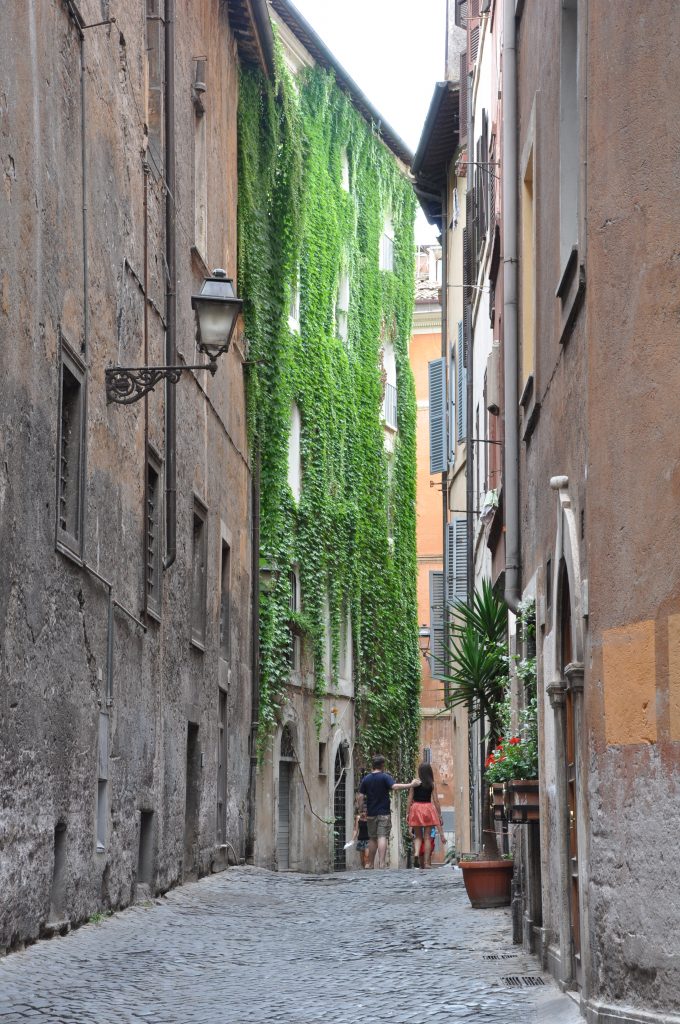
The neighborhood where… it feels most big-city: Via Veneto, Piazza Barberini and Repubblica
This northeastern corner of the historic center is home to the winding Via Veneto. The street is famous for its hotels—although most seem, at least to me, to be huge and overpriced. Meanwhile, the rest of the area, especially near the Barberini and Repubblica metro stops, feels like a big city.
For the most part, forget cobblestones and quaint churches. This is where the buildings are tall, the streets wide, and the passersby businesslike.
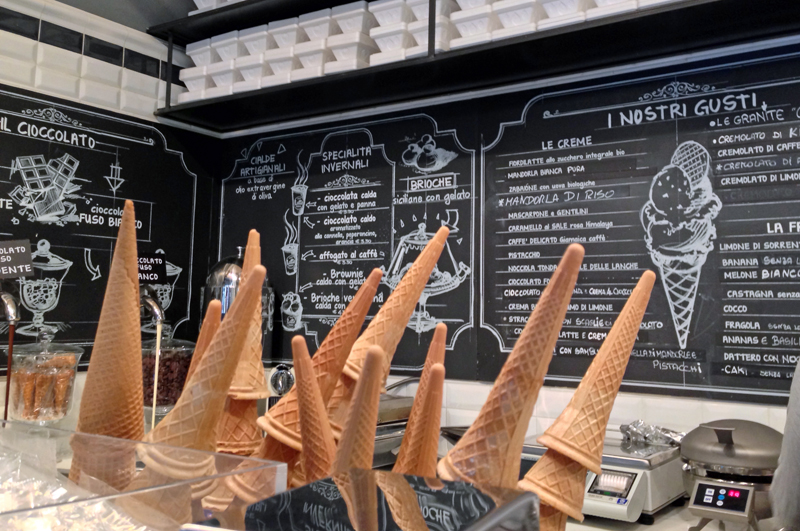
Termini and the Esquiline
Although some hoteliers diplomatically call this neighborhood “Monti,” anything from Piazza Vittorio Emanuele to Santa Maria Maggiore and northeast to the Termini train station is, more properly, the Esquiline hill. In general, the neighborhood here tends to feel gritty and look grungy. This is where you’ll see immigrants hawking counterfeited purses, homeless people huddling in corners, and garbage littering the street.
It’s also home to many of Rome’s cheapest hotels, hostels and B&Bs.
The area tends to be perfectly safe. Rome is, as a whole, much safer when it comes to muggings and violent crimes than pretty much any city in America, as well as Dublin, London and Paris. But it may not be what you imagined when you first pictured Rome. Also keep in mind that, while it may seem very convenient to stay near the train station, and while that means this area is well-connected by metro and bus, it’s not within easy walking distance of most of the major sights, like the Pantheon and Piazza Navona.
Monti
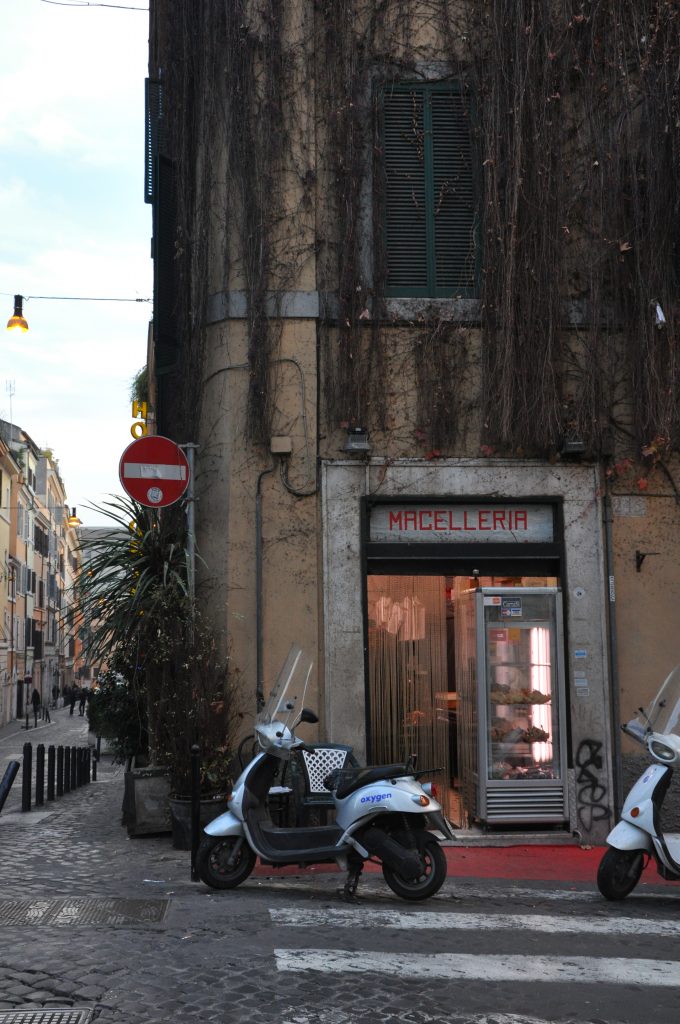
In ancient times, this rione was the red-light district, home to gladiators and prostitutes (Julius Caesar even moved there to show he was “one of the people”). Today, it’s a gorgeous little neighborhood filled with medieval palazzi, cobblestoned streets, and an eclectic mix of traditional trattorie and hip boutiques.
If you want to stay here, look at the area bordered by Via Nazionale (to the west), Santa Maria Maggiore (to the north), the Colle Oppio park (to the east), and the Roman forum and Colosseum (to the south).
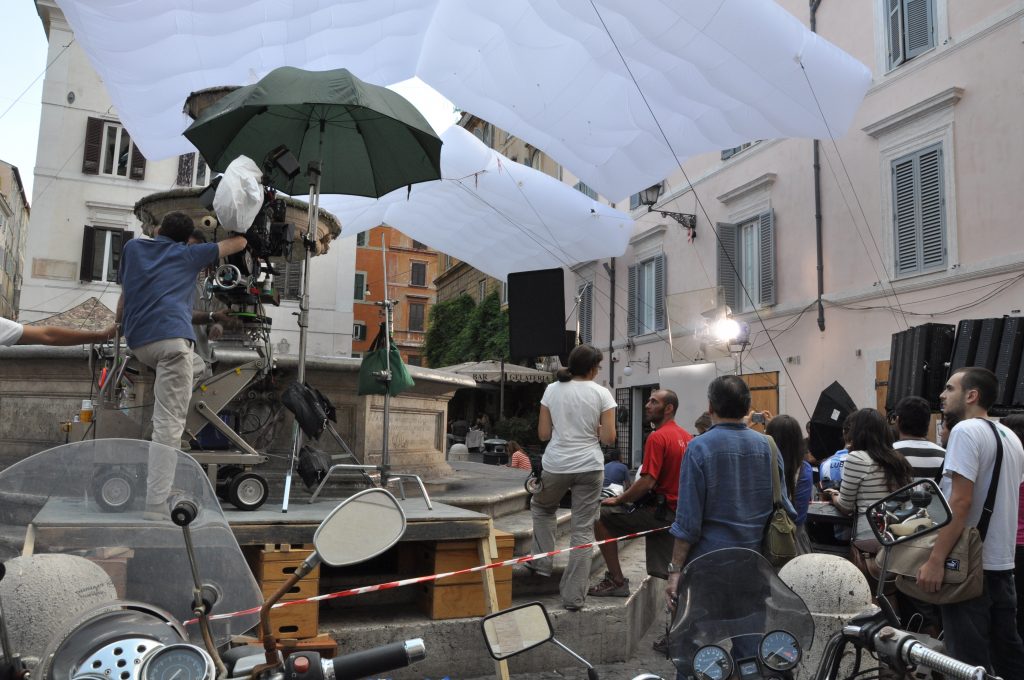
Celio
Further southwest of Monti is Celio, another rione with a strong history. The couple of blocks right around the Colosseum tend to be touristy and busy during the day, but the rest of this area, which stretches southeast to the Basilica of San Giovanni in Laterano, feels quiet and residential. I lived here for four years, and I still think it’s one of the most underrated areas of the city.
Aventine
This hill, just south of the Circus Maximus, is home to some of the loveliest streets and homes in Rome. Its small size and exclusivity mean there are few hotels and B&Bs here. It also doesn’t feel like it’s “in the middle” of anything, thanks to its greenery and the fact that it’s at least a 15-minute walk to most of the major sights.
Forum Boarium
This neighborhood is really a sliver, tucked just to the south and west of Circus Maximus. The neighborhood has some wonderful sights — including the Church of San Giorgio in Velabro, the Arch of Janus, and the Church of San Nicola in Carcere — and it’s just a three-minute walk to the Jewish Ghetto and Piazza Venezia. It’s also tranquil, lovely and off the beaten path.
Campo dei Fiori and the Jewish Ghetto
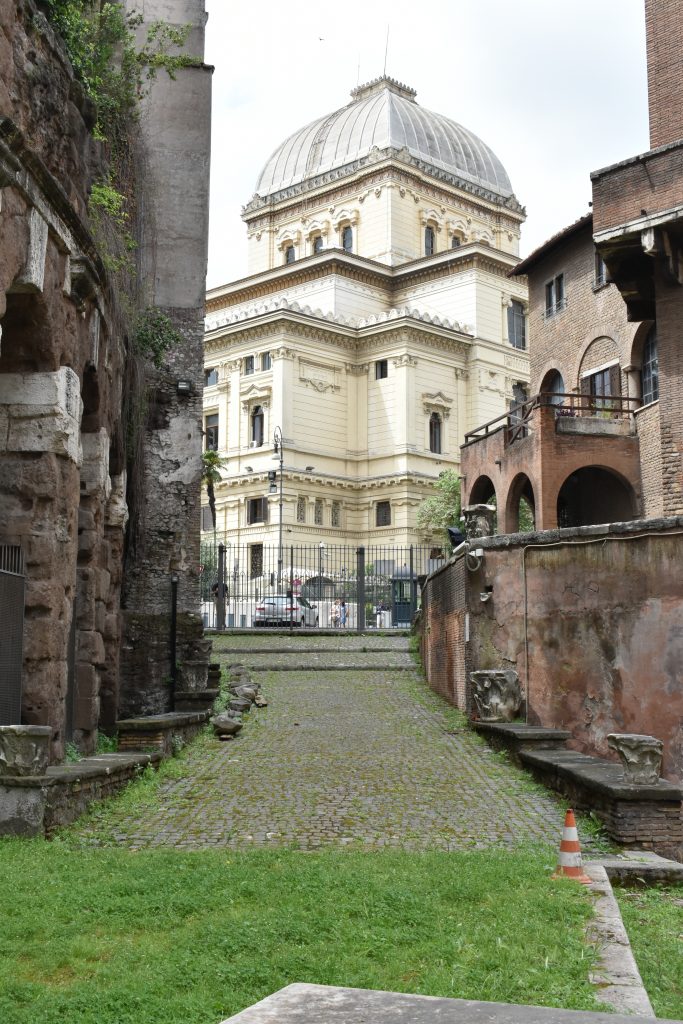
From Piazza Venezia to the Tiber, you’ve got beautiful ancient ruins, the Jewish Ghetto, lively Campo dei Fiori, and my favorite piazza in Rome, Piazza Farnese. This district has the atmosphere (and history) of the area around Piazza Navona and the Pantheon, with half of the people.
Trastevere
Just over the Tiber from Campo dei Fiori and the Ghetto is Trastevere, an atmospheric district that, today, is as likely to be home to American study-abroad students, expats and wealthy Italians as the working-class and bohemian Romans who once lived here. Still, the neighborhood remains charming. There are plenty of corners and tiny streets where life is still lived much as it would have been decades ago.
Prati
If you find the center of Rome’s centro storico too confusing and chaotic, consider Prati. This area around the Vatican, just over the river from sights like Piazza Navona and Piazza del Popolo, was laid out in the 19th century, so its grid system and wide boulevards look more continental and, well, organized than the rest of Rome.
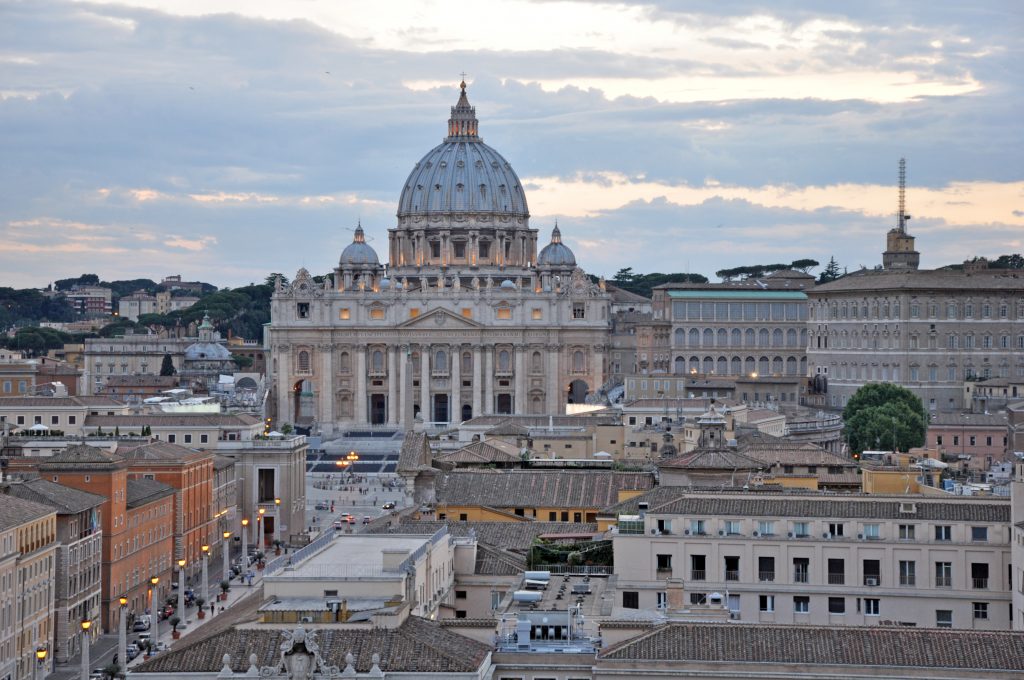
The area right around the Vatican museums and St. Peter’s is extremely touristy. But once you get a little farther away, authentic restaurants and the rhythm of daily life in Rome abound. It’s also easier to find cheaper accommodation here.
Testaccio
Just south of the Aventine, the Testaccio quarter is one of the least touristy in Rome — and has some of the best restaurants and bakeries in the city. The ancient area, which gets its name from “Monte Testaccio,” a hill that literally was created because it was a dump for ancient Roman amphorae, can feel more modern and gritty than the center of the city. But it’s perfectly safe, cheaper than the center, and convenient: Thanks to the metro and lots of buses here, you’re just 5 to 15 minutes away from Trastevere, the Colosseum, and the heart of the historic center.
Also: six of the best trattorias in Rome, how to act like a local and where to find that perfect souvenir or gift in the city.
If you liked this post, you’ll love The Revealed Rome Handbook: Tips and Tricks for Exploring the Eternal City, available for purchase on Amazon or through my site here! I’m also free for one-on-one consulting sessions to help plan your Italy trip.
Five Frustrating Things Someone Coming to Rome Can Say
Over the years, I’ve spoken to a lot of people who are planning their trips to Rome—and I’m speaking to even more of them now. My goal: to help people have the best, most rewarding trip possible to this fantastic city.
So that means that, when someone coming to Rome says one of the five following things to me, I can’t help but feel a little frustrated. Here’s what they are, why I cringe—and how to fix it.
1) I want to eat the best, most authentic food Rome has to offer. Then I want to be able to walk the five minutes back to my hotel at the Trevi Fountain.
 Why it’s frustrating: The biggest misconception about Rome must be that you can eat anywhere and still eat well. False. Rome is like any other city that receives millions of visitors a year: It has a lot of mediocre, overpriced, inauthentic restaurants. That’s especially true in the heart of the centro storico, where tourists tend to hang out. Can you eat relatively well there? Sometimes, and only if you plan your meals. Is it the best food in Rome? Not usually.
Why it’s frustrating: The biggest misconception about Rome must be that you can eat anywhere and still eat well. False. Rome is like any other city that receives millions of visitors a year: It has a lot of mediocre, overpriced, inauthentic restaurants. That’s especially true in the heart of the centro storico, where tourists tend to hang out. Can you eat relatively well there? Sometimes, and only if you plan your meals. Is it the best food in Rome? Not usually.
What you can do: If eating Rome’s most authentic food is important to you, then get familiar with public transportation. As I’ve written before, the #3 bus is the perfect “hop-on, hop-off” bus for foodies. Otherwise, take a taxi: That €10 cab ride might sting, but if you choose your restaurant wisely, you’ll save at least €10 over if you ate in the center. (Here, for example). And you’ll eat better.
2) I’m in Rome for two days. How can I see everything?
Why it’s frustrating: You can’t.
What you can do: Accept that you won’t be able to see “everything” in Rome in two days, and focus on your interests instead. If you get the most enjoyment out of wandering Rome’s quiet, cobblestoned backstreets, do that. If seeing the Vatican and the Pope is really important to you, schedule it in.
Just remember that there’s no “right” way to see Rome. And even if your friends seem appalled, when you return home, that you spent two days in Rome and didn’t see the inside of the Colosseum, you can always smile and say “No, but I did stroll down a 2,300-year-old road between ancient monuments on a gorgeous day/get a dress handmade for me by a Rome designer/see some of the world’s most beautiful works by Raphael, Caravaggio and Bernini. That was my must-do, and I loved it.”
3) I’ve rented a car for the time I’m in Rome. What’s the parking and driving situation like?
 Why it’s frustrating: Although a car can be helpful for getting to Italy’s smaller towns and countryside, if you’re not planning on leaving Rome, there’s no reason to rent a car. The historic center of the city, where most of the sights are, is small enough to traverse on foot, plus most cars aren’t even allowed to enter the area. Parking in the rest of the city is tough. And public transport, despite the stereotype, is pretty good, especially in the center.
Why it’s frustrating: Although a car can be helpful for getting to Italy’s smaller towns and countryside, if you’re not planning on leaving Rome, there’s no reason to rent a car. The historic center of the city, where most of the sights are, is small enough to traverse on foot, plus most cars aren’t even allowed to enter the area. Parking in the rest of the city is tough. And public transport, despite the stereotype, is pretty good, especially in the center.
What you can do: Don’t rent a car. Walk. Take buses. Take the metro. You’ll save yourself a big headache.
4) I booked a hotel way out of the center/near the airport to save money. What’s a good way to get into town each day?

Why it’s frustrating: Hotels in central Rome are expensive. Absolutely. But when people go for the lower prices at hotels located way outside the center, they don’t always calculate in the cost of getting back and forth each day. The Rome Marriott Park Hotel, for example, is located 13 miles outside the center of Rome, and there’s no metro station right nearby. So to get into town, you’ll have to either pay €10 per person for the hotel’s round-trip shuttle (which only leaves at certain times a day), or about €15 for a cab one-way, which goes up at night and on Sundays.
What you can do: Look into your transport options into the heart of Rome before you book your hotel. Where there isn’t public transport, calculate the cost of a taxi or shuttle in advance to make sure the savings are actually worth it. Otherwise, remember that budget accommodation does exist in Rome.
5) We’re just going to play everything by ear.
Why it’s frustrating: Can you come to Rome, not have anything planned in advance, and still see a lot of the city? Sure. But will you wind up spending an inordinate amount of time in lines/money on mediocre meals out? More than likely.
 Case in point: You know you want to see the Colosseum, but you haven’t planned how you’ll do so. You go to the Colosseum in the morning; the line is already two hours long (above). You get approached by an English speaker who tells you that you can skip the line by going on a tour—so you do. But the tour guide is terrible and barely speaks English, and you spend 30 minutes waiting for the whole group to get collected to enter anyway, and you feel rushed through the site. (By the way, this isn’t a rare worst-case scenario. It’s something that happens often).
Case in point: You know you want to see the Colosseum, but you haven’t planned how you’ll do so. You go to the Colosseum in the morning; the line is already two hours long (above). You get approached by an English speaker who tells you that you can skip the line by going on a tour—so you do. But the tour guide is terrible and barely speaks English, and you spend 30 minutes waiting for the whole group to get collected to enter anyway, and you feel rushed through the site. (By the way, this isn’t a rare worst-case scenario. It’s something that happens often).
Had you just looked into things in advance, you could have a) found out where you could get your ticket without having to stand in line or b) researched tour companies and found a Colosseum tour that best suited your interests and with a company renowned for having excellent guides.
What you can do: You don’t have to research everything. But for the sites that have big lines—the Colosseum, St. Peter’s Basilica and the Vatican museums—have a game plan. If you want to eat good food, and don’t want to spend an inordinate amount of money, look up some restaurant recommendations in advance. And if you want to go to the Galleria Borghese or Palazzo Valentini, remember that you must reserve ahead of time.
Also: what weather to expect, where to eat in Rome’s most touristy areas and what to know about crime in Rome.
If you liked this post, you’ll love The Revealed Rome Handbook: Tips and Tricks for Exploring the Eternal City, available for purchase on Amazon or through my site here! I’m also free for one-on-one consulting sessions to help plan your Italy trip.
Rome’s Best Budget Accommodation: Five Places to Stay for Under €80 a Night
One of your biggest expenses in Rome will be accommodation. But you don't have to spend €200 per night on a place where you'll spend most of your time, well, unconscious.
As my first "Five for Friday," here are five of my favorite hotels and B&Bs here in Rome, all costing less than €80 a night. (Prices listed are for low season; in peak season, they are, of course, usually higher).
Hotel de Monti
Why it's great: The new, clean rooms are big for Rome (see photo, top of post). The location, in atmospheric Monti, is one of my favorites; it's a short walk to the Forum or Colosseum, but just off-the-beaten-path enough to feel like a hidden gem (the hotel is on the street pictured above). There's free Wi-Fi. And Alessandro, the multilingual owner, is a local who gives great advice about where to go and what to see.
Why it's budget: It's on the third floor of a well-worn, 16th-century building, without an elevator. Rooms are fairly spartan.
Rooms: From €50 a night. Update, Nov. 2012: Since this blog post was written, prices have changed: From February 2013 onward, prices begin at €144 a night. Via Panisperna 95. +39 064814763. www.hoteldemonti.com
The Beehive

Why it's great: The Beehive's rooms, including hostel and hotel rooms, are cute and colorful. There's free Wi-Fi, linens, and handmade soaps. The Beehive is also eco-conscious, offering an organic, locally-sourced breakfast (for a small extra fee) and all-natural cleaning products. And there's a lovely garden where you can hang out and enjoy the sun.
Why it's budget: Although the location, a stone's throw from Termini, seems convenient, it's not actually the area that most travelers choose to frequent when they're in Rome, and some parts of the neighborhood can feel a bit gritty.
Rooms: From €90 a night (for a private room with private bath), €70 a night (for a private room with a shared bath, shown above), or €20 a night (for a bed in a shared, mixed-gender dorm room). Via Marghera 8. +39 0644704553. www.the-beehive.com
Maison Giulia
Why it's great: Location, location, location! The Maison Giulia is located in a lovely 17th-century palazzo on Via Giulia—a street that just might be the most beautiful in Rome. It's a stone's throw from Campo dei Fiori and Trastevere, and a short walk from Piazza Navona. Rooms are classic "old Rome," with original wood-beamed ceilings. There's free Wi-Fi.
Why it's budget: The rooms are on the small side, and can seem dark. Some online reviews mention that the beds are a little firm.
Rooms: From €79 a night. Via Giulia 189/a. +39 0668808325. www.maisongiulia.it
RetRome Colosseum Garden B&B

Why it's great: Located a stone's throw from the Colosseum in the tranquil, residential Celio neighborhood, the B&B has four cute vintage-inspired rooms. Each has the modern amenities, including an LCD TV, Wi-Fi, and air conditioning. If the B&B is already booked, RetRome has another B&B on Via Veneto as well as several apartments, all in a similar price range.
Why it's budget: The building it's in, although the area is very safe, doesn't look so hot from the outside. In reviews, the B&B has been dinged for poor communication over reservations, for thin windows that let in street noise, and for the Wi-Fi not working.
Rooms: From €80 a night. +39 695557334. Via Marco Aurelio 47. www.retrome.net
Althea Inn
Why it's great: Each room has a private terrace, perfect for enjoying breakfast or an evening glass of wine (above). The rooms are clean, new, and pretty, with pops of purple (below). There's a lot of closet space, a flat-screen T.V. with BBC, and free Wi-Fi. The location is tranquil—perfect for those who don't want to risk the noise of the center—and in Testaccio, an authentic, non-touristy neighborhood that happens to be one of the best districts for dining out.
Why it's budget: Although Testaccio has some great offerings and is just two metro stops from the Colosseum, it's not the center, so you won't walk outside and immediately see, say, Piazza Navona. The street the B&B is on, while safe, isn't particularly pretty.
Rooms: From €70 a night. +39 0698932666. Via dei Conciatori 9. www.altheainn.com
Rome… For People Who Don’t Like Cities
But lots of people want to come to Italy. And when they do, even those people who get hives from traffic and crowds, who break into a sweat taking public transportation or trying to cross a busy street, feel like they have to come to Rome. And I'll be honest: This city is so fantastic, that it's worth getting out of your comfort zone to see.
That said? You can experience Rome in a more tranquil, relaxed way—and there are parts of Rome worth seeing that don't even feel like a city at all.
Here, my top tips for how to fall in love with Rome… even if you don't like cities or crowds.
Come in the off-season

Yes, Rome is, obviously, a city year-round. But in the high season—which runs from Easter to October, with the peak in June and July—it's particularly intense. Thousands of tourists flood the streets. The Sistine Chapel is shoulder-to-shoulder, while you practically have to steamroll people if you want to get close enough to the Trevi Fountain to toss in a coin. So if you're not a fan of crowds, take it from me: Come between late October and early March. The weather will be chillier (and probably rainier), but the major sites will be much, much quieter. (Above: The Spanish Steps in May, or the start of high season. Just imagine what they look like in July!).
Stay in a hotel that really feels like an escape
In general, I strongly recommend that most people stay in Rome's centro storico. That's where you'll spend most of your time sightseeing, and even if hotels outside of the center seem more economic at first glance, the prices of taxis to and from them, or the time lost on public transport, will quickly nullify any savings.
But if you're not fond of cities or crowds, staying right in the heart of the center—in the Spanish Steps area, say, or Piazza Navona—can feel overwhelming. As soon as you step out the door, you'll be thrown onto a street busy with pedestrians and, in some cases, cars. So I recommend one of two things.
First, stay in a hotel in the center… that's small, boutique, and feels like an escape from the city. Don't book one of Rome's many big or chain hotels, where you'll be surrounded by people from breakfast on. Instead, look for hotels like Babuino 181, which, while a stone's throw from the Spanish Steps, is discreet, private, and has a (just-opened) rooftop terrace where you can get a drink, relax in the sun, or read a paper in solitude.
Or, as your second option, stay in a hotel off the beaten path. Like at the sleek Fortyseven Hotel, tucked into the lovely, ruins-sprinkled Forum Boarium area; it's a 5-minute walk from Piazza Venezia, but since it's in the opposite direction from where everyone else goes, it feels like a hidden gem. Or at Hotel Donna Camilla Savelli, a 17th-century convent, built by famed architect Borromini, that's tucked into the Janiculum hill, just a 5-minute walk from Trastevere (at top, the hotel's courtyard). Or, for a budget option, the RetRome Colosseum Garden B&B, which, while a stone's throw from the Colosseum, is on a tranquil, residential street that few tourists wander up. Don't go too far—having to deal with too much public transport will just replace all of the stress you're trying to get away from—but remember that you don't have to. Just a short walk from the main sites in Rome can get you off the beaten path.
Enjoy Rome's great outdoors
While you might not realize it at first glance, Rome has a lot of green space. So if the sound of sirens makes you wince, make a plan for how you'll get back to nature. I've written about three of Rome's prettiest parks, including Villa Borghese (Rome's "Central Park"), Monte Mario, and Villa Pamphili, before. Others to check out include the wild-feeling and forested Villa Ada; next to the Colosseum, there's the small but lovely Villa Celimontana.
And I can't say enough how much a stroll down the Appian Way will make you feel like you've traveled back in time—and to a Rome of greenery and parks and bikes and ruins and rambling villas. City? What city?
Chill out in churches
No, not St. Peter's Basilica. Many of Rome's (other) churches are hidden gems, and you just might be the only person there.
Don't deal with lines
This is advice I'd give anyone, but if you're crowd-averse, pay particular attention. Don't go to the Vatican museums in the morning, avoid them on a Saturday or Monday, and never, ever go on the "free day" (the last Sunday of the month). Visit St. Peter's Basilica in the evening, rather than during the day.
And when going to the Colosseum, don't get in the always-absurd line stretching out front; get your combined Colosseum, Forum and Palatine ticket from the desks at the Forum or Palatine entrances. (Before 2pm, especially in the summer, these, too, can sometimes be long. Go in the afternoon, and remember that you can use your ticket—one entrance per site only—for 24 full hours, so if you only have time to visit the Forum before it closes, you can go back the next day for the Colosseum and Palatine. No waiting in line necessary). (Above, by the way, is the line for the Bocca della Verita, or "Mouth of Truth." Frankly, there's no way to skip this line… but this is also never necessary to wait in, unless you just can't leave Rome without that photo op).
Give yourself time to relax and people-watch
I find a city most feels like a city—in the stressful, chaotic, high-pressure sense of the word—when I'm rushing around and trying to do a million things at once.
So, when in Rome… don't. Build extra time into your schedule. Plan to sit at a cafe (although be very careful which cafe you choose, and steer clear of those on main piazzas or at tourist sites). Or do like the Romans do and relax over a nice, long lunch. In the evening, enjoy a stroll through the cobblestoned streets, gelato in hand.
And even if you're not a city person, you will fall in love with Rome.
You might also like:
The Best Gelato, and Best-Kept Secret, in Rome
Should I Use Public Transport? And Other Bus- and Metro-Related Questions
The Most Romantic Hotels in Rome
The most romantic hotels and B&Bs in Rome–perfect for a honeymoon or other romantic break!
 Planning a honeymoon in Rome… or simply looking for a romantic break? Here's my list of the eight of the most romantic Rome hotels!
Planning a honeymoon in Rome… or simply looking for a romantic break? Here's my list of the eight of the most romantic Rome hotels!
Of course, one person's amore-inspiring room is another person's crazy-maker. So let's break it down. If your idea of romance means….
Knights, turrets and damsels:

Then stay at: Hotel Campo de Fiori (above and top left). Located in a Renaissance-era palazzo right on Campo de Fiori (luckily, given the piazza's popularity with late-night carousers, all the windows are fully soundproofed), the boutique hotel's 23 rooms come with the kinds of details that'll make you feel like you've fallen into a fairytale—think velvet headboards, elaborate tapestries, wood-beamed ceilings, crystal chandeliers, and ornate gilt frames, even for the flat-screened televisions. As with most Rome hotel rooms, the standard rooms aren't particularly spacious, and they tend to be on the dim side. But that's all part of the Olde Worlde romance. Doubles start at €150 a night. Via del Biscione, 6. +39 0668806865.
Or: Hotel Manfredi Suite in Rome (above). This 2-year-old hotel hides in an 18th-century palazzo on artsy Via Margutta. Rooms aren’t big (they start at 140 square feet), but with their deep colors, ornate wallpaper, and elaborate gold frames, they still manage to feel nearly regal. For more space, opt for a deluxe, which starts at 215 square feet—or live like a king in a 430-square-foot junior suite. Doubles start at €150 a night. Via Margutta, 61. +39 063207676.
Sexy times:
Then stay at: Spagna Royal Suite. This brand-new boutique hotel has details so sensuous, they'd be ridiculous—if they weren't so cool. Think unusual features like an in-room steam sauna or mosaic Jacuzzi, not to mention lots of play with textures and lighting, with everything from leather to snakeskin to gold gilt showing up on the walls. Rooms start at €200 a night. Via Mario de’ Fiori, 3. +39 0669923793.
Or: Suite Sistina (above). At this little boutique hotel, tucked behind an almost-anonymous door on the street that runs from the top of the Spanish Steps, every detail sets the mood, from the silk sheets to velour throws to the Bang & Olufson stereos. Some of the rooms have particularly sexy touches, like Jacuzzis right in the bedroom or big round beds. Doubles start at €170 per night. Via Sistina, 53. +39 0620368380.
Five-star sunsets—and service:
Then stay at: Hotel Palazzo Manfredi (above). On the rooftop of this 9-year-old boutique hotel, watch the sun set over the Colosseum while savoring a meal (white truffle-scented creme brulee, anyone?) in the upmarket restaurant “Aroma.” The 16 rooms run “European-sized,” but boast all the luxe amenities, from Nespresso machines to creative lighting. Wi-Fi is free, and iPads are lent to guests, too. The biggest sell, though, remains the view: Six rooms look out at the Colosseum, six see the lovely Parco di Traiano with its ruins, and three view a street lined with 17th-century buildings. Doubles start at €260 a night. Via Labicana, 125. +39 0677591380.
Or: Hotel Raphael. Located just off Piazza Navona, the 5-star Hotel Raphael has set Rome’s standard for elegance since its 1963 opening. Traditional rooms feature tapestry hangings and velvet curtains; if your tastes run modern, ask for one of the 2nd– or 3rd-floor rooms, which were redesigned by famous architect Richard Meier. Regardless of the room, enjoy amenities like the welcome drink, daily newspaper, and Bulgari toiletries—not to mention the stunning 360-degree view from the rooftop restaurant. Doubles start at €250 a night. Largo Febo, 2. +39 06682831.
The effortlessness—and privacy—of home:
Then stay at: Crossing Condotti (above). If you find the idea of having lots of stuff around you stressful, then book one of the five rooms at this enchanting little residence, located a stone's throw from the Spanish Steps. With soft palettes and clean lines, all given some personality by touches like wood-beamed ceilings and antique furniture (it actually comes from the family of the Sicilian prince that runs the place), the rooms exude a charm that's elegant, not over the top. The place runs more like private apartments than a hotel, meaning there's no 24/7 reception: You have your own keys and let yourself in and out when you want. Doubles start at €180 a night. Via Mario de' Fiori, 28. +39 06 69920633.
Or: Mario de Fiori 37. This little residence, tucked (as you might expect) into the same lovely street as Crossing Condotti, features four homey rooms that hit the right luxe notes, like Frette sheets, free Wi-Fi, Nespresso machines, and king-sized beds. The smallest room is a spacious 215 square feet, but for the ultimate in coziness and privacy, spring for the 377-square-foot attic apartment (shown below). This is another spot that isn't a "hotel," but a residence—meaning, again, your own keys, privacy and independence in lieu of a 24-hour reception. Doubles start at €220 a night. Via Mario de' Fiori, 37. +39 0669921907
Please note: Although I visited each of these hotels and B&Bs myself, all of the photos are courtesy of the hotels.
Want to Know Where to Stay in Rome? Check Out National Geographic Traveller
 Want to know where to find the best accommodation in Rome? You could check out my articles on the best B&Bs and boutique hotels in Rome for the Guardian.
Want to know where to find the best accommodation in Rome? You could check out my articles on the best B&Bs and boutique hotels in Rome for the Guardian.
Or you could pick up the National Geographic Traveller (that’s the UK version of the magazine) March/April 2012 issue to find my favorite hotels in Rome—this time, organized by neighborhood. (Hello, Prati/Monti/Trastevere/”heart of the centro storico.” Love you all.) On newsstands now. (You can also find it online here).
(A third option is in the works: I’m working on beefing up my “accommodation” section on this blog. The first attempt is this post on the most romantic hotels in Rome).






